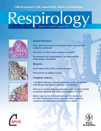Reticular basement membrane fragmentation and potential epithelial mesenchymal transition is exaggerated in the airways of smokers with chronic obstructive pulmonary disease
ABSTRACT
Background and objective: In COPD, the airways are chronically inflamed, and we have now observed fragmentation of the reticular basement membrane (Rbm). This appears to be a hallmark of the process known as epithelial mesenchymal transition (EMT), in which epithelial cells migrate through the Rbm and differentiate into fibroblasts. The aim of this study was to confirm the extent and relevance of Rbm fragmentation in smokers and patients with COPD, and to undertake a preliminary analysis of some classical markers of EMT.
Methods: Endobronchial biopsies from current smokers (CS; n = 17) and ex-smokers with COPD (ES; n = 15), smokers with normal lung function (NS; n = 16) and never-smoking control subjects (NC; n = 15) were stained for the EMT markers, S100A4, vimentin, epidermal growth factor receptor and matrix metalloproteinase-9.
Results: Compared with NC, there was significant Rbm fragmentation in the CS, ES and NS groups, which was positively associated with smoking history in subjects with COPD. Staining for basal epithelial S100A4, epithelial epidermal growth factor receptor and matrix metalloproteinase-9 in cells within Rbm clefts, and for S100A4 in Rbm cells, was increased in the CS, NS and ES groups compared with the NC group. There was also increased Rbm cell S100A4 staining in the CS group compared with the ES and NS groups. Basal epithelial cell staining for S100A4 was inversely correlated with airflow limitation. Double staining for both S100A4 and vimentin further strengthened the likelihood that these changes represented active EMT.
Conclusions: This is the first detailed description of fragmentation and cellularity of the Rbm in smokers, which were most marked in subjects with COPD. The data are consistent with active EMT in these subjects.




